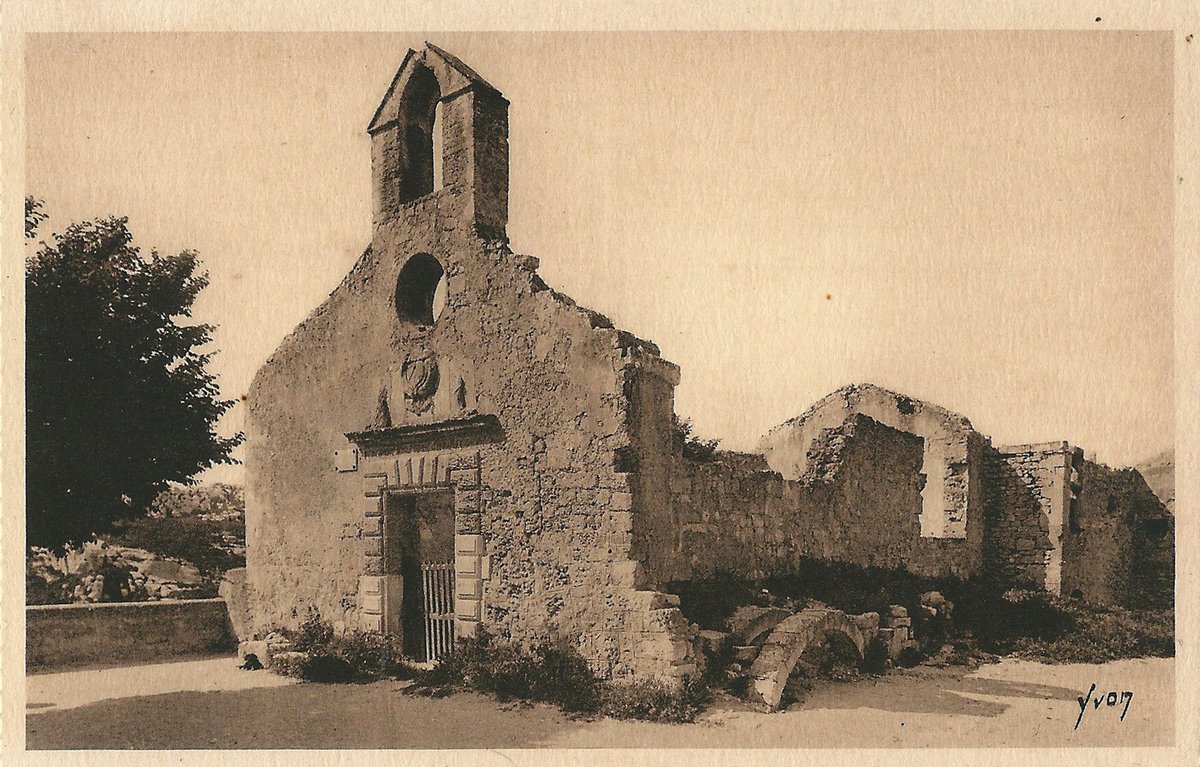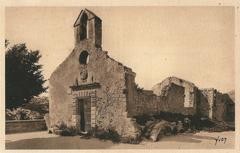
Chapelle des Pénitents Blancs Les Baux-de-Provence: Visiting Hours, Tickets, and Historical Significance
Date: 14/06/2025
Introduction
The Chapelle des Pénitents Blancs, situated in the captivating village of Les Baux-de-Provence, is a remarkable symbol of Provence’s spiritual heritage and cultural resilience. Built in 1650 by the Confraternity of the White Penitents, this chapel has served as a cornerstone for religious devotion, community solidarity, and artistic innovation for centuries. Its architectural elegance, cliffside setting, and unique frescoes by Yves Brayer make it an essential stop for anyone seeking to immerse themselves in the region’s history, art, and traditions (Provence Guide).
This guide provides a detailed overview of the chapel’s historical and cultural context, architectural evolution, practical visitor information, and tips to enhance your experience.
Table of Contents
- Introduction
- Origins and Foundation
- Architectural Features and Evolution
- The White Penitents: Role and Influence
- Artistic Heritage: Yves Brayer’s Frescoes
- Visiting Hours, Tickets, and Accessibility
- Historical and Cultural Significance
- Preservation and Heritage Status
- Key Dates and Milestones
- Chapel in Contemporary Context
- Frequently Asked Questions (FAQ)
- Plan Your Visit and Nearby Attractions
- Summary and Recommendations
- References
Origins and Foundation
The Chapelle des Pénitents Blancs was established in 1650 by the Catholic lay brotherhood known as the White Penitents, who were dedicated to acts of charity, penance, and community service. Their emergence in Les Baux-de-Provence reflected a broader movement across France in response to religious strife and societal upheavals. The village’s precarious location atop the Alpilles mountains provided both strategic significance and spiritual symbolism, marking the chapel as a place of resilience for a community emerging from the turbulence of the Wars of Religion (Les Baux-de-Provence Official).
Architectural Features and Evolution
The chapel is a fine example of modest Provençal religious architecture. Its rectangular nave, limestone façade, and bell-gable (clocher-mur) reflect the restrained elegance associated with 17th-century confraternity chapels. The vaulting inside was designed to foster contemplation and spiritual elevation, while the stonework—using local materials—blends harmoniously with the rugged landscape.
Over time, the chapel underwent several restorations to maintain its structural integrity and adapt to changing uses. Notably, in the 1970s, the interior was transformed by the addition of vivid frescoes by Yves Brayer, breathing new life into the space while respecting its historical character (France-Voyage).
The White Penitents: Role and Influence
The White Penitents were pivotal in shaping the spiritual and social landscape of Les Baux-de-Provence. Known for their acts of charity—caring for the sick, aiding the poor, and supporting the community during crises—they organized processions and religious festivals, particularly around major liturgical events. Their presence ensured that the chapel remained not just a place of worship, but a hub for community support and cohesion (Provence Guide).
Artistic Heritage: Yves Brayer’s Frescoes
One of the chapel’s signature features is the cycle of frescoes created by Yves Brayer between 1974 and 1976. These murals depict the Nativity set within a distinctly Provençal context, featuring local shepherds, villagers, and landscapes. Brayer’s frescoes use traditional techniques and bold colors, integrating sacred themes with the region’s folklore and daily life.
This artistic intervention not only revitalized the chapel’s interior, but it also established a dialogue between past and present, highlighting the ongoing vitality of Provençal cultural identity (Yves Brayer Museum).
Visiting Hours, Tickets, and Accessibility
- Visiting Hours: Typically open daily from 10:00 AM to 6:00 PM, with potential extended hours during the summer season. Hours can vary during holidays or special events. It is best to confirm current schedules on the official website.
- Tickets: Admission is usually free, though donations for upkeep are welcome. Occasionally, special events or exhibitions may require a modest entry fee.
- Accessibility: The chapel is accessible via the village’s cobbled lanes. While the chapel itself is partially accessible, the surrounding terrain may pose challenges for those with mobility issues. Advance inquiries are recommended for specific needs.
- Guided Tours: Available in French and English, guided tours offer valuable insights into the chapel’s history and art. These can be booked via the tourist office or on-site.
Historical and Cultural Significance
The Chapelle des Pénitents Blancs is integral to the history of Les Baux-de-Provence. It stands as a testament to the village’s endurance through periods of conflict, religious reform, and social change. As one of the few remaining structures linked to the powerful tradition of lay brotherhoods, it preserves the memory of a community united by both faith and mutual aid (Les Baux-de-Provence Official).
Preservation and Heritage Status
Designated as a Monument Historique in 1981, the chapel benefits from legal protection and ongoing restoration efforts. Its status ensures the safeguarding of both its historical architecture and Brayer’s frescoes for future generations. Local partnerships and the support of cultural organizations facilitate educational programming and regular maintenance (Ministère de la Culture).
Key Dates and Milestones
- 1650: Chapel constructed by the White Penitents
- 19th Century: Restoration after periods of neglect
- 1974–1976: Yves Brayer paints Nativity frescoes
- 1981: Listed as a Monument Historique
- Present: Ongoing public access, restoration, and cultural events
Chapel in Contemporary Context
Today, the chapelle serves not only as a historical monument but also as a venue for cultural events, art exhibitions, and occasional religious services. Its intimate size and excellent acoustics make it a favored site for concerts and community gatherings, especially during festival seasons (Les Baux-de-Provence Events).
Frequently Asked Questions (FAQ)
Q: What are the visiting hours?
A: Typically 10:00 AM to 6:00 PM daily, with variations during holidays or special events.
Q: Is there an entry fee?
A: Admission is generally free; donations are encouraged. Special events may require tickets.
Q: Are guided tours available?
A: Yes, in both French and English. Book via the tourist office or onsite.
Q: Is the chapel wheelchair accessible?
A: Access is partial; the surrounding cobbled streets may be challenging.
Q: Can I take photos inside?
A: Yes, but flash is discouraged to protect the frescoes.
Plan Your Visit and Nearby Attractions
- Location: Central Les Baux-de-Provence, near Place Louis Jou and other landmarks.
- Getting There: Accessible by car (with parking nearby) or by regional bus from Avignon/Arles.
- Nearby Sites: Château des Baux, Église Saint-Vincent, Carrières de Lumières, local museums, artisan shops, cafés, and restaurants (Les Baux Village Map).
- Visitor Tips: Visit early or late in the day for fewer crowds and the best light for photography. Respect the site’s contemplative atmosphere, especially during events.
Summary and Recommendations
The Chapelle des Pénitents Blancs is a living homage to the enduring spirit of Les Baux-de-Provence. Its harmonious blend of architectural simplicity, vibrant art, and cliffside beauty provides a unique entry point into the region’s history and culture. Whether you’re drawn by its spiritual tranquility, its artistic treasures, or its role in Provençal identity, the chapel offers a deeply enriching experience.
For an optimal visit, check for current hours and events, consider a guided tour, and explore the surrounding village. Support ongoing preservation through donations or by attending cultural events. Enhance your experience further with the Audiala app for curated tours and insights.
References
- Provence Guide
- Petit Futé
- France-Voyage
- Yves Brayer Museum
- Les Baux-de-Provence Official
- Les Baux-de-Provence Events
- Ministère de la Culture
Explore the Chapelle des Pénitents Blancs for an inspiring journey through Provence’s spiritual, artistic, and communal legacy.
